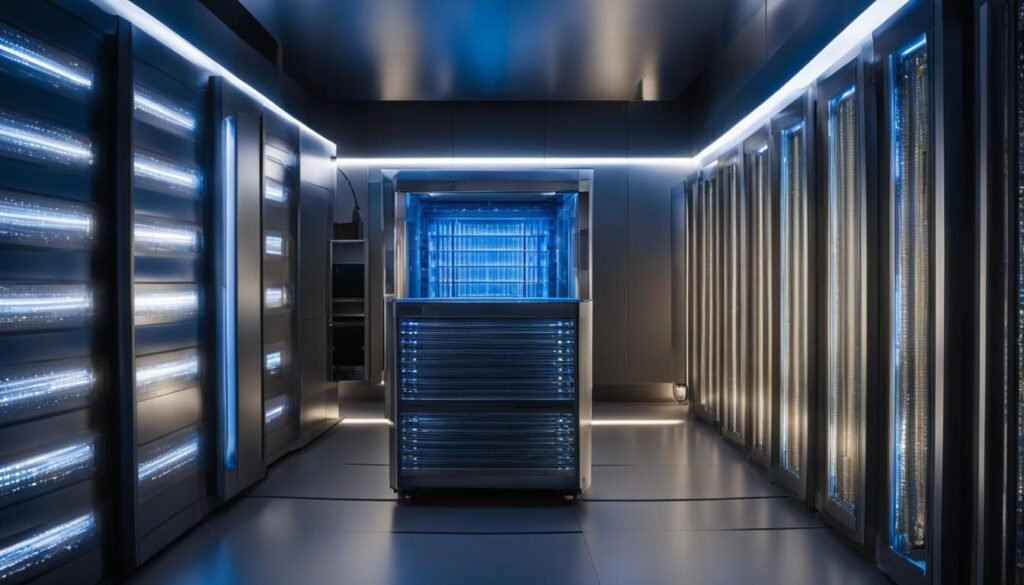Contents
- 1 The Need for Increased Storage Capacity
- 2 How Laser-assisted Magnetic Recording Works
- 3 Availability, Capacity, and Performance
- 4 Price, Reliability, and Compatibility
- 5 The Rise of DNA Storage
- 6 The Transformative Potential of Plasma and Laser Technologies
- 7 FAQ
- 7.1 What is Laser-assisted Magnetic Recording?
- 7.2 How do HAMR and MAMR technologies address storage challenges?
- 7.3 When can we expect higher capacity hard drives utilizing HAMR and MAMR technologies?
- 7.4 Will HAMR and MAMR drives be compatible with existing systems?
- 7.5 What are the advantages of DNA storage?
- 7.6 How can plasma and laser technologies revolutionize data storage systems?
- 8 Source Links
As digital storage technology continues to evolve, laser-assisted magnetic recording (HAMR and MAMR) is emerging as a promising solution for unlocking future storage capabilities. These innovative technologies offer the potential to significantly increase storage capacity and data density, addressing the limitations posed by current storage methods. Let’s explore how laser-assisted magnetic recording is poised to revolutionize the world of storage.
Key Takeaways:
- Laser-assisted magnetic recording (HAMR and MAMR) technologies aim to increase storage capacity and data density.
- By 2025, manufacturers like Seagate and Western Digital plan to release hard drives surpassing the 40 TB threshold.
- Laser-assisted magnetic recording overcomes the limitations of current storage technologies, paving the way for larger capacity hard drives.
- The rapid growth of media libraries has created a need for increased storage capacity, which laser-assisted magnetic recording seeks to address.
- Plasma and laser technologies have transformative potential in data storage systems, offering increased capacity and enhanced data reliability.
The Need for Increased Storage Capacity
The rapid growth of media libraries, fueled by ultra-high-resolution sensors and raw video cameras, has created a pressing need for increased storage capacity. As content creators produce larger and more data-intensive files, the limitations of current storage solutions become apparent. Hard drive capacity has remained stagnant over the past few years, unable to keep up with the exponential growth of data. Additionally, cloud storage, while promising, is limited by internet speed and can be costly for large-scale storage needs.
To address these challenges, the development of laser-assisted magnetic recording technologies such as HAMR and MAMR has gained momentum. These innovative techniques aim to revolutionize data storage by significantly increasing storage capacity and data density. By leveraging the power of lasers and microwaves, HAMR and MAMR technologies offer a promising solution for industries relying on large data storage, such as photographers, videographers, and media production companies.
With the ever-increasing demand for higher storage capacities, HAMR and MAMR technologies have the potential to unlock a new era of data storage. By overcoming the limitations of current storage solutions, these technologies pave the way for more efficient and scalable storage options. As the volume and complexity of data continue to grow, it is crucial to invest in advanced storage technologies to meet the needs of the present and future.
The Impact on Media Libraries
Media libraries, in particular, are facing a storage crisis as the size and number of files continue to expand. High-resolution images, videos, and other multimedia content require substantial storage space, pushing the boundaries of existing storage solutions. Content creators, from professional photographers to filmmakers, are constantly searching for efficient ways to manage and store their ever-growing libraries.
Laser-assisted magnetic recording technologies offer a glimmer of hope, as they promise to unlock higher storage capacities without compromising performance or reliability. By harnessing the power of lasers and microwaves, these technologies can write data with greater precision and density, allowing for more data to be stored on a single drive. This breakthrough in storage capacity will greatly benefit media professionals, providing them with the necessary resources to manage their expanding media libraries.
The Future of Storage
The need for increased storage capacity is not limited to media libraries alone. From scientific research to healthcare, industries across the board are grappling with the issue of data storage. As the world becomes increasingly data-driven, finding efficient and scalable storage solutions becomes paramount.
HAMR and MAMR technologies represent a significant step forward in addressing the challenges of storing and managing large amounts of data. With their ability to increase storage capacity and data density, these laser-assisted magnetic recording technologies offer a glimpse into the future of data storage. By providing more storage space in a smaller footprint, these technologies empower industries to continue pushing the boundaries of innovation and knowledge.
How Laser-assisted Magnetic Recording Works

Laser-assisted Magnetic Recording (HAMR) and Microwave-assisted Magnetic Recording (MAMR) are cutting-edge technologies that aim to revolutionize data storage by overcoming the limitations of conventional magnetic media. HAMR utilizes a small 200 mW laser beam to heat up the disk platter, allowing for precise data writing. On the other hand, MAMR employs microwave frequencies to decrease the coercivity of the disk platter, making it easier to write data.
These energy-assisted recording techniques enable the use of high coercivity materials, which are harder and more stable than those used in traditional magnetic recording. By utilizing these materials and the assistance of energy during the writing phase, HAMR and MAMR technologies strive to achieve higher data density and increased storage capacity.
HAMR and MAMR pave the way for larger capacity hard drives in the near future, addressing the pressing need for increased data storage capacity.
The combination of advanced materials and energy assistance in HAMR and MAMR not only enables higher storage capacities but also offers the potential for faster transfer speeds and quicker access to data. This makes them particularly valuable for industries reliant on large data storage, such as photography, videography, and cloud-based services.
The Advantages of HAMR and MAMR
One of the key advantages of HAMR and MAMR technologies is their ability to push the boundaries of storage capacity. As manufacturers continue to refine these technologies, we can expect to see hard drives with capacities exceeding 40 TB in the near future. This will greatly benefit professionals and businesses that require vast amounts of storage space for their media libraries and big data applications.
Additionally, HAMR and MAMR drives offer improved performance thanks to their higher data density. With more data packed into each square inch of the disk platter, they can achieve faster transfer speeds and reduced latency. This is especially crucial in industries where access to data needs to be near-instantaneous.
| HAMR | MAMR | |
|---|---|---|
| Coercivity of Disk Platter | Higher | Lower |
| Energy Assistance | Laser | Microwave |
| Storage Capacity | 40+ TB (Expected) | 40+ TB (Expected) |
| Transfer Speed | Faster | Faster |
| Latency | Lower | Lower |
In conclusion, HAMR and MAMR technologies offer exciting advancements in data storage by combining high coercivity materials, energy assistance, and innovative recording techniques. These technologies are poised to meet the growing demand for increased storage capacity and faster access to data, making them invaluable assets for professionals and industries relying on large-scale data storage.
Availability, Capacity, and Performance
Western Digital and Seagate, two leading manufacturers in the data storage industry, are poised to bring laser-assisted magnetic recording (HAMR and MAMR) drives to market in the near future. These technologies promise increased storage capacity and data density, addressing the growing need for larger storage solutions.
Currently, Western Digital is already sampling 16 TB models of their laser-assisted magnetic recording drives, while Seagate plans to begin volume shipments this year. These drives are expected to offer significantly higher storage capacity compared to current perpendicular magnetic recording (PMR) drives. By 2023, Seagate anticipates delivering hard drives with capacities exceeding 40 TB, and Western Digital aims to surpass the 40 TB threshold by 2025.
The performance of laser-assisted magnetic recording drives will be directly correlated to their capacity. Higher density platters will enable faster transfer speeds, providing users with quicker access to their stored data. However, it’s important to note that latency, the delay in retrieving data from the drive, will still depend on the rotation speed of the drives.
To summarize, laser-assisted magnetic recording drives are on the cusp of availability, offering unprecedented storage capacity to meet the growing demand for data storage solutions. These drives will not only provide greater storage capacity but also enhance performance with faster transfer speeds, revolutionizing the way we store and access data.
Price, Reliability, and Compatibility
In addition to addressing the need for increased storage capacity, HAMR and MAMR technologies also raise questions about price, reliability, and compatibility. These factors are crucial for consumers and organizations considering the adoption of these new drives.
The price of HAMR and MAMR drives is a key consideration for many buyers. While the exact pricing of these technologies is yet to be determined, manufacturers expect the cost-per-TB to decrease as data centers adopt them on a larger scale. With their increased capacity, HAMR drives have the potential to offer a reduced cost-per-TB compared to traditional PMR drives.
Reliability is another important aspect to consider when evaluating the performance of HAMR and MAMR drives. Seagate, for example, has already tested thousands of HAMR drives with millions of heads, demonstrating their reliability and robustness. Manufacturers are investing significant resources to ensure the reliability of these new technologies.
Compatibility is also a critical factor for consumers and businesses. The good news is that both HAMR and MAMR drives are designed to be compatible with existing systems. This means that users can seamlessly integrate these new drives into their current setups without the need for significant infrastructure changes.
Overall, while the exact pricing and long-term reliability of HAMR and MAMR drives are still being determined, the potential cost-per-TB reduction, proven reliability testing, and compatibility with existing systems make these technologies promising options for those in need of increased storage capacity.
The Rise of DNA Storage

DNA storage is an emerging technology that holds immense promise for the future of data storage. By leveraging the natural information storage capabilities of DNA, scientists and researchers are exploring new horizons in data storage capacity, durability, and computational functions.
One of the key advantages of DNA storage is its high storage capacity. DNA molecules can store vast amounts of digital information, with potential storage densities in the order of petabytes per gram. This makes it highly suitable for long-term archival storage needs, such as preserving valuable historical records, scientific data, and cultural heritage.
DNA storage also offers exceptional durability, as DNA molecules can remain intact and readable for thousands of years under proper storage conditions. This longevity makes it a promising solution for industries and organizations that require long-term data preservation.
Artificial Gene Sequences and Computational Functions
Artificial gene sequences play a crucial role in DNA storage. By encoding digital information into synthetic DNA molecules, scientists can store and retrieve data using laboratory techniques. These artificial gene sequences can be created and synthesized to represent any type of digital information, from text and images to music and videos.
Furthermore, DNA storage shows potential for computational functions beyond simple data storage. Scientists have demonstrated the ability to perform computations using DNA-based algorithms, opening up possibilities for DNA storage to serve as a platform for data processing and analysis.
The Future of Data Storage
While DNA storage technology is still in its early stages of development, it holds great promise for the future of data storage. With its high storage capacities, durability, and potential computational functions, DNA storage could revolutionize the way we store and access data.
As research and development in DNA storage continue, it is essential to address challenges such as cost, scalability, and data retrieval methods. However, the transformative potential of DNA storage makes it an exciting area to watch, with the possibility of creating a new paradigm in data storage and preservation.
The Transformative Potential of Plasma and Laser Technologies
Plasma and laser technologies are poised to revolutionize the world of data storage systems. With their high-speed data writing capabilities and holographic data storage potential, these technologies have the power to reshape the future landscape of data storage and processing.
Plasma technologies offer a range of benefits, including increased storage capacity, rapid data access, and enhanced data reliability. The use of plasma in data storage allows for greater storage density, meaning more data can be stored in a smaller physical space. Additionally, plasma-based systems enable faster data retrieval, reducing latency and improving overall performance. This makes them particularly well-suited for applications where quick and efficient data access is crucial.
Laser technologies, on the other hand, open up new possibilities with holographic data storage. By using lasers to create intricate interference patterns, data can be stored in three dimensions, offering significantly higher storage densities compared to traditional storage methods. Laser-enabled holographic data storage also allows for ultra-fast writing and reading speeds, enabling swift access to large amounts of data. Furthermore, laser-based systems provide long-term data integrity, ensuring that stored information remains intact and accessible over extended periods of time.
These transformative plasma and laser technologies have far-reaching implications across a wide range of industries. In healthcare, they can enable efficient and secure storage of large medical datasets, improving diagnostics and research capabilities. In finance, these technologies can enhance data security and facilitate more advanced analytics. In the entertainment industry, plasma and laser technologies can enable the storage and delivery of high-resolution video content. Additionally, in scientific research, these technologies can help manage and process massive amounts of experimental data.
FAQ
What is Laser-assisted Magnetic Recording?
Laser-assisted Magnetic Recording (HAMR and MAMR) is an innovative technology used to increase storage capacity and data density in hard drives.
How do HAMR and MAMR technologies address storage challenges?
HAMR and MAMR technologies aim to overcome the limitations of current magnetic media by utilizing energy assistance during the writing phase and utilizing harder, more stable materials.
When can we expect higher capacity hard drives utilizing HAMR and MAMR technologies?
Seagate expects to release 40 TB+ hard drives utilizing HAMR technology by 2023, while Western Digital plans to surpass the 40 TB threshold with MAMR technology in 2025.
Will HAMR and MAMR drives be compatible with existing systems?
Yes, both HAMR and MAMR drives are designed to be compatible with existing systems.
What are the advantages of DNA storage?
DNA storage offers high storage capacities, durability, and the potential for computational functions beyond simple data storage.
How can plasma and laser technologies revolutionize data storage systems?
Plasma technologies offer increased storage capacity, rapid data access, and enhanced data reliability, while laser technologies enable holographic data storage, ultra-fast writing and reading speeds, and long-term data integrity.



